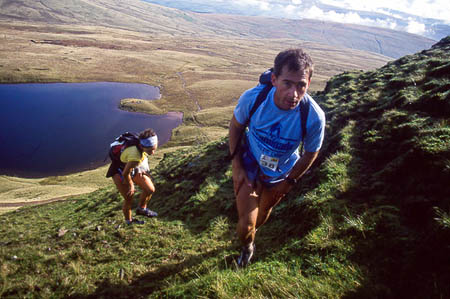
Martin Stone and Helene Diamantides in the Black Mountains, south Wales, on day five of the Dragon's Back. Photo: Rob Howard/www.sleepmonsters.com
On an overcast evening in September 1992, two weary but determined runners toiled up steep limestone cliffs to reach the ruins of Carreg Cennen castle in South Wales and complete the inaugural Dragon’s Back Race.
Martin Stone and Helene Diamantides ran into the central courtyard of the castle for a historic victory after completing five days of running down the mountainous spine of Wales, racing 200 miles over rock-strewn and boggy mountain paths, and having climbed some 60,000 feet – twice the height of Everest – on the way.
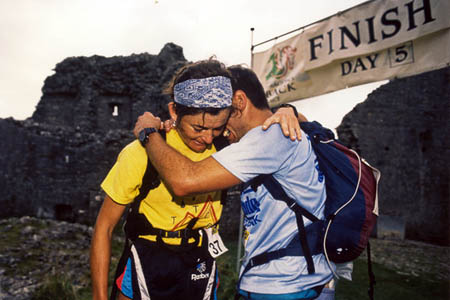
An emotional moment for the winners: Martin Stone and Helene Diamantides at the Carreg Cennen Castle finish line. Photo: Rob Howard/www.sleepmonsters.com
They had navigated through foul weather and fought back to win after losing the lead on the final day, and at the finish Stone collapsed in tears, leaning against his partner, overcome with exhaustion and emotion.
The pair had beaten the top British and US mountain runners of the day, entries from the UK’s elite armed forces, and international competition including three times Spartathlon winner, Rune Larsson of Sweden, and Stefan Schlett of Germany, the world’s most prolific endurance runner.
An internationally screened TV documentary and widespread newspaper and magazine coverage focused largely on Diamantides’s success in what is still regarded as one of the toughest mountain races ever organised.
After such an outstanding success it seemed the Dragon’s Back Race would be a fixture on the race calendar. Yet, it never took place again… until now that is.
After a decade in which that original and inspirational race has lived on only in running legend and lore, it is to return. September 2012 will see the return of the Dragon’s Back Race.
That the race has retained its iconic status through the years is testament to its classic concept and enduring challenge. It was writer John Gillham who originally realised the mountains of Wales formed a sinuous spine running north-south from coast to coast through the country.
In his book Snowdonia to the Gower, he described a walk along this route and this inspired long distance runner Ian Waddell to organise a stage race for charity. The Dragon’s Back Race was born, though at the time he anticipated a low-key race with a few competitors, never expecting to attract a major oil company as a sponsor and to see the race screened on televisions all over the world.
The runners on the first race mainly competed in pairs, for safety, though there were a few brave solos, some by choice, others because no partner could be found, or when the severity of the early stages forced their partners to retirement.
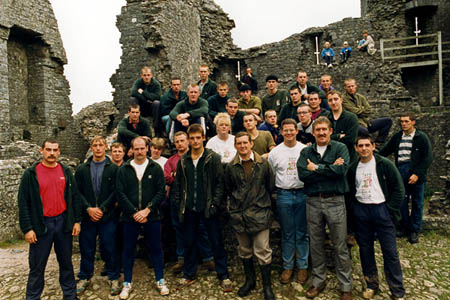
The support team of Paras that provided all the logistics, cooking and accommodation for the competitors. Photo: Rob Howard/www.sleepmonsters.com
Mountains of food, camp beds, tents and even showers were provided each night by the Parachute Regiment Depot to sustain the runners and allow them to rest between the arduous stages.
The race route began beneath the imposing ramparts of Conwy Castle on the north Wales coast – Wales has a lot of castles – and the first day took the runners over the biggest mountain ranges in Wales, the Carneddau, the Glyders and the Snowdon range.
This was the shortest day at 36½ miles, but one of the toughest, and in the poor weather navigation and competence on mountain terrain soon became crucial. Larsson, who once ran 162 miles in a single day, had opted to run alone, but got into difficulties on Tryfan peak, where some scrambling is required.
“On the first day I was lost in the mist in a strange country and felt very alone,” he said. “Then I was trapped on a rock face, frightened and thinking of my seven-month-old son, so my desire for competition changed to a basic will to survive.”
All of the competitors found navigation a challenge at times, and even the leaders lost their way on the final day, having to regain the lead in the final two hours of the race, which they completed in a total time of 38hrs 38mins. Stone said: “It isn’t just a distance race; you need skill with a map and compass to find your way and experience to run over rough and steep ground, which requires different techniques.”
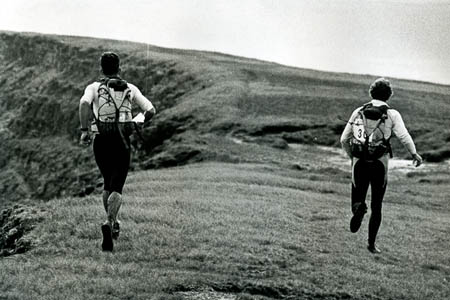
John Redmayne and Rob Collister although seen here moving together in the Black Mountains, actually raced as solo competitors. Photo: Rob Howard/www.sleepmonsters.com
The other four days ranged from 44 to 47 miles, and on the longest days – two and five, even the winners took more than eight hours, while the stragglers were out long after dark.
Several pairs took 13 or 14 hours for these days. For the record the quickest solo competitor was John Redmayne in 42hrs 59mins, and the quickest ladies pair was Sue Walsh and Wendy Dodds in 54hrs 06mins. The slowest finishers over the full course took more than 68 hours and only 16 of the 32 pairs who started made it to the finish.
It seems unlikely many of those original racers will return to the revised Dragon’s Back Race, but there will be no shortage of challengers from the current generation of endurance and trail runners. Within weeks of news of the race being re-launched more than 100 enquiries had come in from all over the world – and this was before the race was publicised. Many of these may be rejected as the applicants won’t have the necessary skills or experience to tackle the Dragon’s Back.
The new organiser is outdoor consultant Shane Ohly, 34, who has set long-distance mountain running records in the UK himself, and has worked as a race director at endurance races in the past.
When asked why he wanted to revive the race he said: “Conceptually, the Dragon’s Back Race is close to my heart as a pure mountain running experience, as I believe that there is no ‘real’ adventure without risk and that there is no ‘real’ satisfaction without effort.
“I want to run the whole route myself during the planning stages, both for my own satisfaction and so that I can look every competitor in the eye – and dismiss any of their moans about the enormity of the challenge.”
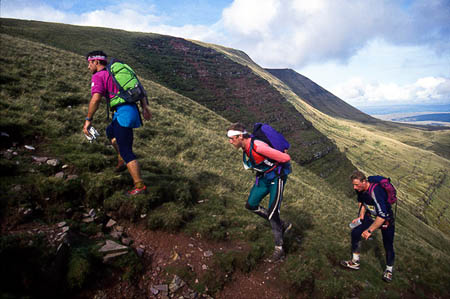
From left: Joe Faulkner, Rune Larsson and Steve Dubienec in the Black Mountains in south Wales. Photo: Rob Howard/www.sleepmonsters.com
Ohly is looking to find 100 racers ready to take on the Dragon’s Back in September next year and has put in place a vetting procedure, though the rate of enquiries is such he will soon have a wait list as well.
“The competitors will need to have experience in mountain and endurance running, as well as navigation,” he said. “The race will be unsupported with fixed camps, and the route will be very similar to the original, with the same start and finish points.
“The original race route was a classic and I will be true to that.”
More details of the race can be found on the new website at www.dragonsbackrace.com and entries can be made via the website.
James Martin
09 October 2011Wow, this is amazing!